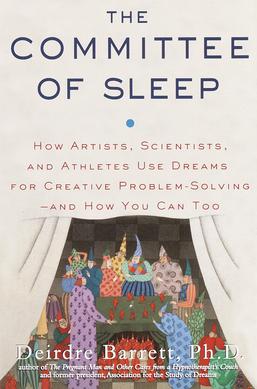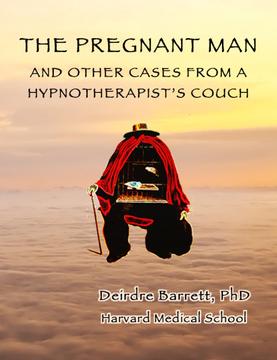
A lucid dream is a type of dream in which the dreamer becomes aware that they are dreaming while dreaming. During a lucid dream, the dreamer may gain some amount of control over the dream characters, narrative, or environment; however, this is not actually necessary for a dream to be described as lucid. Lucid dreaming has been studied and reported for many years. Prominent figures from ancient to modern times have been fascinated by lucid dreams and have sought ways to better understand their causes and purpose.
Robert Stickgold is a full professor of psychiatry at the Harvard Medical School and the Beth Israel Deaconess Medical Center. A sleep researcher, his work focuses on the relationship between sleep and learning. His articles in the popular press are intended to illustrate the dangers of sleep deprivation.

A dream is a succession of images, ideas, emotions, and sensations that usually occur involuntarily in the mind during certain stages of sleep. Humans spend about two hours dreaming per night, and each dream lasts around 5 to 20 minutes, although the dreamer may perceive the dream as being much longer than this.

In medicine, traumatology is the study of wounds and injuries caused by accidents or violence to a person, and the surgical therapy and repair of the damage. Traumatology is a branch of medicine. It is often considered a subset of surgery and in countries without the specialty of trauma surgery it is most often a sub-specialty to orthopedic surgery. Traumatology may also be known as accident surgery.
Psychological trauma, mental trauma or psychotrauma is an emotional response to a distressing event or series of events, such as accidents, rape, or natural disasters. Reactions such as psychological shock and psychological denial are typical. Longer-term reactions include unpredictable emotions, flashbacks, difficulties with interpersonal relationships and sometimes physical symptoms including headaches or nausea.
Hypnagogia is the experience of the transitional state from wakefulness to sleep: the hypnagogic state of consciousness, during the onset of sleep. Its opposite state is described as hypnopompic —the transitional state from sleep into wakefulness. Mental phenomena that may occur during this "threshold consciousness" phase include hypnagogic hallucinations, exploding head syndrome, lucid dreaming, and sleep paralysis. The latter two phenomena are themselves separate sleep conditions that are sometimes experienced during the hypnagogic state.
Betrayal is the breaking or violation of a presumptive contract, trust, or confidence that produces moral and psychological conflict within a relationship amongst individuals, between organizations or between individuals and organizations. Often betrayal is the act of supporting a rival group, or it is a complete break from previously decided upon or presumed norms by one party from the others. Someone who betrays others is commonly called a traitor or betrayer. Betrayal is also a commonly used literary element, also used in other fiction like films and TV series, and is often associated with or used as a plot twist.
Dream incubation is a thought technique which aims for a specific dream topic to occur, either for recreation or to attempt to solve a problem. For example, a person might go to bed repeating to themselves that they will dream about a presentation they have coming up, or a vacation they recently took. While somewhat similar to lucid dreaming, dream incubation is simply focusing attention on a specific issue when going to sleep.
Susan A. Clancy is a cognitive psychologist and Associate professor in Consumer behaviour at INCAE as well as a Post-Doctoral Fellow at Harvard University. She is best known for her controversial work on repressed and recovered memories in her books Abducted and The Trauma Myth.

Complex post-traumatic stress disorder is a psychological disorder that is theorized to develop in response to exposure to a series of traumatic events in a context in which the individual perceives little or no chance of escape, and particularly where the exposure is prolonged or repetitive. It is not yet recognized by the American Psychiatric Association or the DSM-5 as a valid disorder, although was added to the eleventh revision of the International Classification of Diseases (ICD-11). In addition to the symptoms of post-traumatic stress disorder (PTSD), an individual with C-PTSD experiences emotional dysregulation, negative self-beliefs and feelings of shame, guilt or failure regarding the trauma, and interpersonal difficulties. C-PTSD relates to the trauma model of mental disorders and is associated with chronic sexual, psychological, and physical abuse or neglect, or chronic intimate partner violence, bullying, victims of kidnapping and hostage situations, indentured servants, victims of slavery and human trafficking, sweatshop workers, prisoners of war, concentration camp survivors, and prisoners kept in solitary confinement for a long period of time, or defectors from authoritarian religions. Situations involving captivity/entrapment can lead to C-PTSD-like symptoms, which can include prolonged feelings of terror, worthlessness, helplessness, and deformation of one's identity and sense of self. C-PTSD is linked to adverse childhood experiences, especially among survivors of foster care.
Judith Lewis Herman is an American psychiatrist, researcher, teacher, and author who has focused on the understanding and treatment of incest and traumatic stress.

John Allan Hobson was an American psychiatrist and dream researcher. He was known for his research on rapid eye movement sleep. He was Professor of Psychiatry, Emeritus, Harvard Medical School, and Professor, Department of Psychiatry, Beth Israel Deaconess Medical Center.
Childhood trauma is often described as serious adverse childhood experiences (ACEs). Children may go through a range of experiences that classify as psychological trauma; these might include neglect, abandonment, sexual abuse, emotional abuse, and physical abuse, witnessing abuse of a sibling or parent, or having a mentally ill parent. These events have profound psychological, physiological, and sociological impacts and can have negative, lasting effects on health and well-being such as unsocial behaviors, attention deficit hyperactivity disorder (ADHD), and sleep disturbances. Similarly, children with mothers who have experienced traumatic or stressful events during pregnancy can increase the child's risk of mental health disorders and other neurodevelopmental disorders. Kaiser Permanente and the Centers for Disease Control and Prevention's 1998 study on adverse childhood experiences determined that traumatic experiences during childhood are a root cause of many social, emotional, and cognitive impairments that lead to increased risk of unhealthy self-destructive behaviors, risk of violence or re-victimization, chronic health conditions, low life potential and premature mortality. As the number of adverse experiences increases, the risk of problems from childhood through adulthood also rises. Nearly 30 years of study following the initial study has confirmed this. Many states, health providers, and other groups now routinely screen parents and children for ACEs.
Memory and trauma is the deleterious effects that physical or psychological trauma has on memory.

Deirdre Barrett is an American author and psychologist known for her research on dreams, hypnosis and imagery, and has written on evolutionary psychology. Barrett is a teacher at Harvard Medical School, and a past president of the International Association for the Study of Dreams and of the American Psychological Association’s Div. 30, the Society for Psychological Hypnosis. She is editor-in-chief of the journal Dreaming: The Journal of the Association for the Study of Dreams and a consulting editor for Imagination, Cognition, and Personality and The International Journal for Clinical and Experimental Hypnosis.
The effects of domestic violence on children have a tremendous impact on the well-being and developmental growth of children witnessing it. Children who witness domestic violence in the home often believe that they are to blame, live in a constant state of fear, and are 15 times more likely to be victims of child abuse. Close observation during an interaction can alert providers to the need for further investigation and intervention, such as dysfunctions in the physical, behavioral, emotional, and social areas of life, and can aid in early intervention and assistance for child victims.
Perpetrator trauma, also known as perpetration- or participation-induced traumatic stress , occurs when the symptoms of posttraumatic stress disorder (PTSD) are caused by an act or acts of killing or similar horrific violence.

The Committee of Sleep: How Artists, Scientists, and Athletes Use Dreams for Creative Problem-Solving—and How You Can Too is a book by Deirdre Barrett published by Crown/Random House in 2001. Barrett is a psychologist on the faculty of Harvard Medical School. The book describes how dreams have contributed practical breakthroughs to arts and sciences in the waking world. Chapters are organized by discipline: art, literature, science, sports, medicine, etc. There are long examples of dreams which led to major achievements in each area, but Barrett then draws conclusions about how dreams go about solving problems, what types they are best at, and gives advice on how readers can apply these techniques to their own endeavors. Those who are described in The Committee of Sleep as having dreamed creations include Ludwig van Beethoven, Billy Joel, Robert Louis Stevenson, Stephen King, Salvador Dalí, William Blake, and Nobel prize winner Otto Loewi.

The Pregnant Man and Other Cases from a Hypnotherapist's Couch is a book by Deirdre Barrett published by W. W. Norton & Company in 2010. Barrett is a psychologist on the faculty of Harvard Medical School. The book describes seven real patients, disguised for anonymity, who Barrett treated with hypnotherapy. They are presented in chronological order, beginning when the author was a trainee, so that much information about hypnosis is woven into the stories as Barrett herself is learning. The title character is a transgender man who develops false pregnancy after the death of his boyfriend. Other patients include an asthmatic with a heavy smoking habit, a wealthy aristocrat with a fear of flying, a writer who suddenly can't read, and two very different cases of multiple personality. The book concludes with a section on how interested readers can locate a reputable hypnotherapist.
David J. Morris is an American writer and former Marine infantry officer.








